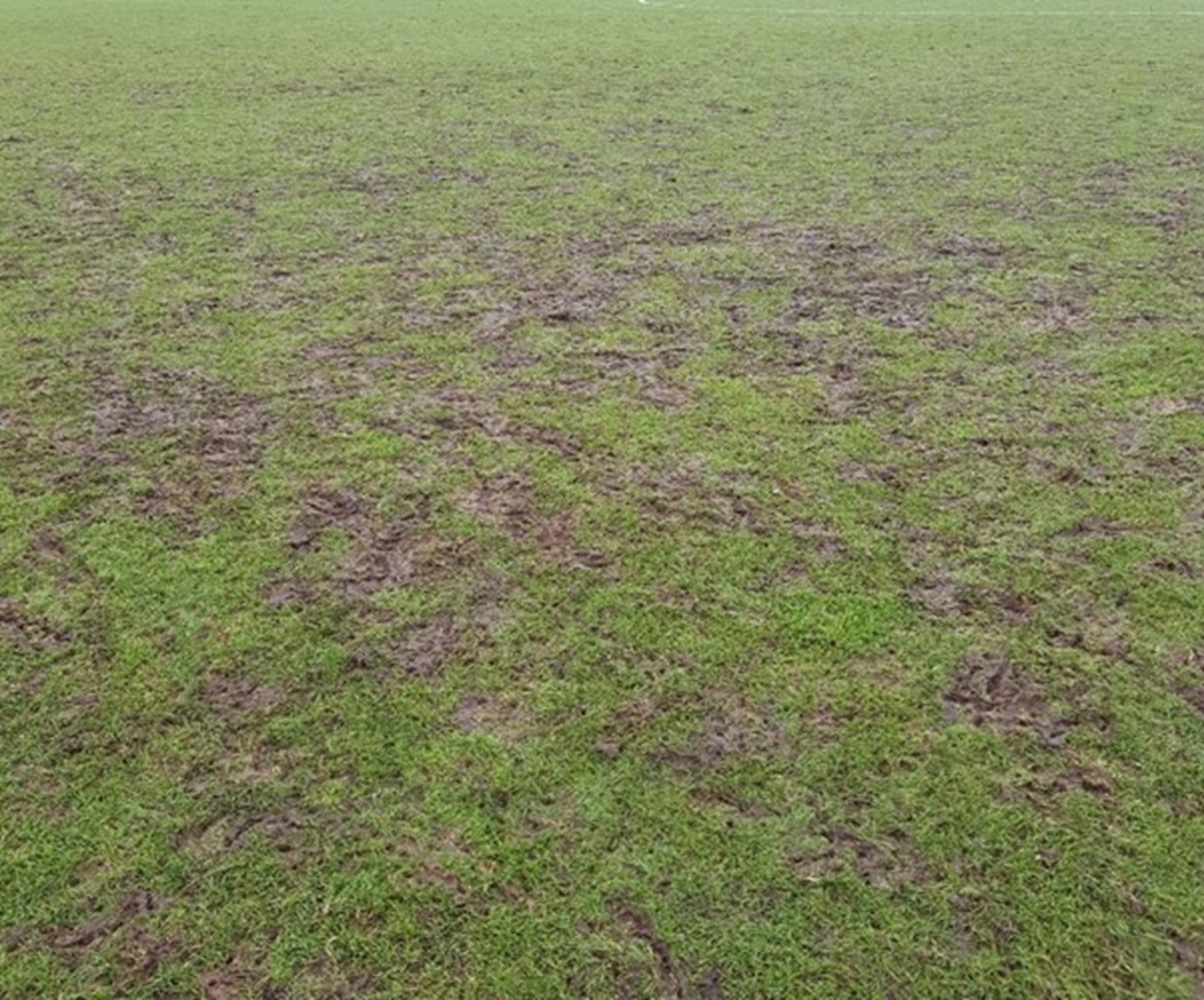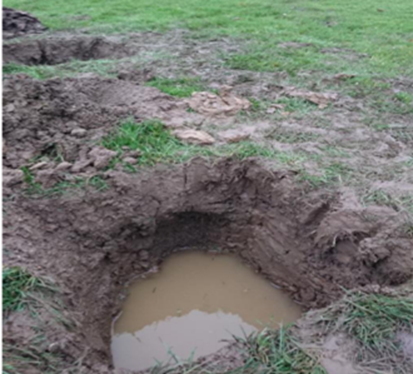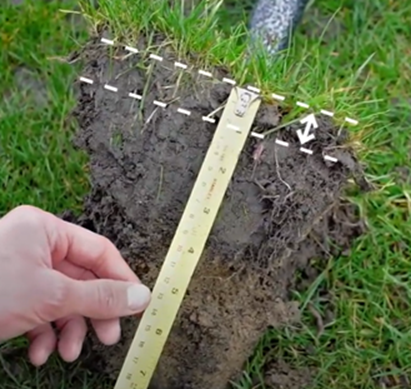Dealing with pitch use in wet and waterlogged conditions
Where to start….
The first thing to say is that it’s important to try and consider pitch usage from all perspectives when assessing whether training or more importantly fixtures should go ahead in wet weather. Whilst the hours of preparation and potential repair, pitch condition and the short- and long-term effects of play will be at the forefront of the groundpersons mind its helpful to be mindful of other factors. Club officers and coaches will be thinking about fixture congestion, team and supporter travel, coach and player availability for rearranged fixtures and loss of revenue amongst other things, whilst match officials tend to deal in the here and now and will primarily be focused on player safety and pitch playability.
Know your enemy….
If you know your site is susceptible to waterlogging its helpful to understand what causes it on your particular site and this is best done during the winter months. Looking at the soil profile (on the pitch) or digging test pits (off pitch) to keep an eye out for any thatch layers, soil compaction, soil debris, soil pans or groundwater can be a good place to start.
High water table - It could be a groundwater issue meaning any rainfall simply has nowhere to drain away until the water table subsides (in this scenario preventative or reactive localised forking and deep spiking will have little effect and if the soil is already saturated will make the problem worse) You’ll end up with holes full of water. Low lying sites or ones close to water courses are typically amongst those affected by this.
Thatch – Thatch layers build up when turf produces organic matter more quickly than it can be broken down. It consists of layers of dead shoots, stems and roots that can create a thick matt through which water, oxygen and nutrients penetrate slowly. Think of thatch as a sponge between the grass and soil, the thicker the sponge the more water it holds. Thatch can be removed through scarification and broken down by regular aeration.
Soil compaction – One of the major contributors to waterlogging can be compacted soils, this can be on the surface but also in the soil profile. If soils are squashed together through play and machinery use and the compaction is not relieved through slitting and deep spiking for example you may suffer from compacted soils significantly slowing the penetration of water to the subsoil below. If you suffer from waterlogging and look at the soil profile and find your soil is drier at depth it’s a good indicator that soil compaction and/or a thatch layer are contributing to the problem. In this scenario hand forking, deep spiking and slitting should be effective in the right conditions as it will help create channels to the permeable drier soils below.
Soil debris and pans – You may find that your topsoil is friable and drains well but then at a given depth you have a hard impermeable layer or one that contains lots of soil debris. Again, this will slow water penetration, water moving through the topsoil will start to back up if it hits an impermeable layer that drains very slowly. If your soil becomes wetter at depth this could be a cause. If shallow enough (in the top 200-300mm) decompaction can help to break down compacted layers.
Getting the best from a weather forecast….
Once you have established that your site is susceptible to waterlogging, knowing roughly how much rainfall your pitches can cope with over time is very useful. A simple rain gage costing a few pounds collects rainwater and can be used to measure rainfall in a given period. If you know for instance that your pitches are typically playable following say 15mm of rain in a 24hour period, you can use a decent weather forecast to make an educated guess. If 20mm of rain is forecast in the next 24 hours you’re probably going to be in trouble. If you live close by you don’t necessarily have to collect the rainwater on site.
Increasingly we are getting extreme rainfall events that are seeing large amounts of rain in short periods of time. As before if you can see that a large amount of rain is forecast during or in the preceding hours to your scheduled game or training session this should ring alarm bells.
When is wet too wet?
Certain tasks can be carried out prior to the arrival of wet weather providing your pitch is dry enough, slitting, deep spiking and hand forking of trouble spots can all help to get games on if carried out in the days prior to a scheduled usage. Remember the golden rule though, soils must be moist, NOT wet, any sign of drawing up water underfoot or with machinery or smeared mud on tines it is too wet you will do more harm than good and actually likely increase the risk of a cancelation by sealing up the pitch surface and compacting the soil.
A groundspersons rule of thumb will usually be that if there is standing water before kick-off then it’s a no go. Equally if you can draw up water by treading on the surface and further rain is forecast during the game or training session its very likely there will be standing water during play.
If the pitch is touch and go in the hours before scheduled use, try and use the weather information mentioned previously to make an educated prediction of whether pitch condition is likely to improve or deteriorate.
Know the rules and communicate....
It’s helpful to familiarise yourself with the rules of your respective league where potential postponement of fixtures is concerned. Some leagues will allow the home club/venue to postpone a match but in many instances this will come down to the match official. You can find the FA guidance for pitch inspections by following the link, https://www.thefa.com/-/media/cfa/global/files/referees/pitch-inspection-guidance.ashx this is typically what referees should be abiding by. You may find it helpful to communicate this to away teams and officials in advance or display them in the changing rooms for reference.
As mentioned earlier, everyone in football will have their own set of priorities when thinking about whether a fixture or training session should go ahead or not. Do not expect that others will think about the playing surface in the same terms as you will even though it may seem common sense to you.
If you are expecting weather that is likely to disrupt play, try and communicate this within the club at the earliest possible opportunity and importantly make sure you express your concerns and the potential impact on the playing surface both in the short and long term. It can be helpful to keep a record of who was informed and when, this might include coaches, club officers, persons from the away team and match officials. This will help if you were to receive criticism for the condition of the pitch at a later date.
We will come on to the potential impact of playing in wet conditions shortly but it is important to have reasonable knowledge of the time and resources that may be needed to reinstate a damaged pitch both in the short and medium term when putting across your point of view. Also take time to listen to the factors at play for others involved, it takes a lot of logistics to play a football match whatever the level and equally impacts on a lot of people when matches are postponed.
Game on? what to expect….
If the training session or fixture is going ahead try and see if coaching staff will meet you halfway and limit the intensity of pre match warmups and during half time, this might involve running drills taking place off the pitch, and limiting warm ups to corners or areas outside of the 18 yard boxes. Asking the linesperson to run opposite lines can be worth a go too.
In most situations playing on a wet pitch will lead to increased wear to the playing surface and most likely divots, scrapes and scars. If there is standing water playability will be impacted and the playing experience diminished, also consider that without adequate traction a pitch will likely be unsafe and the risk of player injury increases.
In the short term, play on saturated ground will reduce the likelihood of being able to play the next time there is a usage following or during wet weather as mentioned before when soil is compacted its capacity to drain water is reduced this compaction is exacerbated when the soils are already wet. What will most likely happen is on a week when the pitch is expected to be fit it won’t be.
The aftermath….
Whether a game or training session starts and is then abandoned or completed there will be some damage (likely severe) to contend with.
There are a few key things to think about;
Short term
It's good practice to document the damage that has been done by taking pictures. Along with documenting any warnings given prior to use this will help to protect the groundsperson from criticism in the following weeks and months and can be helpful in proving a point the next time the situation occurs.
- Keep off the pitch, if the pitch is saturated and muddy and even more so if there is standing water the best thing that can be done is to keep off altogether and wait for the pitch to dry out adequately before attempting any repair works. You will probably be able to carry out repairs by hand first. Any sign of drawing up water underfoot or with machinery stay off and come back another day, you will do more harm than good, sometimes the best decision is to do nothing at all.
- Whilst onerous, divot repair is one of the simplest ways of repairing damage, try and at least put back any big divots to avoid a bobbly surface
- Most people will have access to a garden fork to put back some divots but a pedestrian drag brush can be another affordable and useful tool for standing the grass back up. Whilst some grass will have been kicked out some will simply have been trodden down into the wet soil.
- Only once there is no evidence of water being drawn up under foot or by equipment should the use of machinery be considered. If you are fortunate enough to have access to a tractor and combination grooming tool these are excellent for recovering pitches after use.
- Equally pedestrian rotary mowers or ride on rotary mowers can be used to hoover up debris and reinstate the pitch if available.
Medium term
- It will be necessary to carry out aeration and decompaction operations as soon as conditions allow to alleviate the compaction caused by play in wet conditions. This helps to reintroduce some of that crucial pore space in the soil but soil conditions must be right.
- If pitches are severely worn and do not recover adequately then renovation works will be essential to prevent weed invasion and make sure pitches are fit for purpose the following season.




 Tweet
Tweet